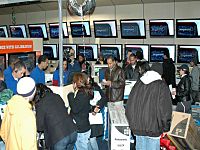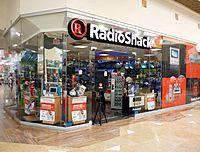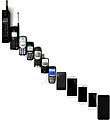Consumer electronics facts for kids

Consumer electronics or home electronics are electronic equipment intended for use by everyday use, typically in private homes.
Radio broadcasting in the early 20th century brought the first major consumer product, the broadcast receiver. Later products included telephones, televisions and calculators, then audio and video recorders and players, game consoles, personal computers and MP3 players. In the 2010s, consumer electronics stores often sell GPS, automotive electronics (car stereos), video game consoles, electronic musical instruments (e.g., synthesizer keyboards), karaoke machines, digital cameras, and video players (VCRs in the 1980s and 1990s, followed by DVD players and Blu-ray disc players). Stores also sell digital cameras, camcorders, cell phones, and smartphones. As of 2016, some of the newer products sold include virtual reality head-mounted display goggles, smart home devices that connect home devices to the Internet (such as smartphone-controllable thermostats and lights) and wearable technology such as Fitbit digital exercise watches.
In the 2010s, most consumer electronics have become based on digital technologies, and have largely merged with the computer industry in what is increasingly referred to as the consumerization of information technology.
Many consumer electronics have planned obsolescence, resulting in E-waste.
Images for kids
-
A modern flat panel, HDTV television set
-
Gramophone factory in Hannover-Nordstadt
-
This picture illustrates how the mobile phone industry evolved to what we see today as modern smartphones
-
Electronic waste: discarded electronic equipment
See also
 In Spanish: Electrónica de consumo para niños
In Spanish: Electrónica de consumo para niños








